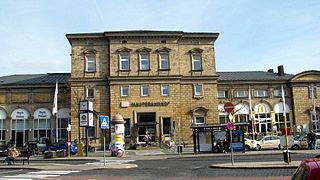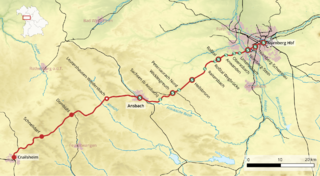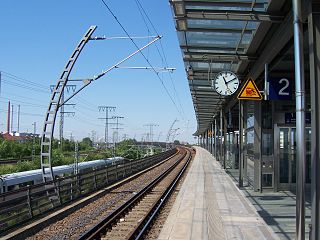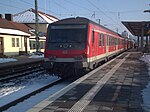
The Nuremberg U-Bahn is a rapid transit system run by Verkehrs-Aktiengesellschaft Nürnberg, which itself is a member of the Verkehrsverbund Großraum Nürnberg. The Nuremberg U-Bahn is Germany's newest metro system, having begun operation in 1972, although the Nuremberg-Fürth route (U1) uses part of the right of way of the Bavarian Ludwig Railway, Germany's first passenger railway opened in 1835. The current network of the U-Bahn is composed of three lines, serving 49 stations, and comprising 38.2 kilometres (23.7 mi) of operational route, making it the shortest of the four metro systems in Germany, behind Berlin, Hamburg and Munich.

Nürnberg Hauptbahnhof or Nuremberg Central Station is the main railway station serving the city of Nuremberg in Germany. It is the largest station in Franconia and belongs to the 20 stations in the highest category of importance allocated by DB Station&Service.

Fürth (Bayern) Hauptbahnhof is a railway hub for the city of Fürth in Bavaria, Germany. The station is mainly frequented by regional services. It also has a connection to the Nuremberg U-Bahn (underground) system and the Nuremberg S-Bahn (commuter) network.

Bayreuth Hauptbahnhof is the main railway station in the German town of Bayreuth, in northern Bavaria.

The U1 is an underground line in Nuremberg. The first part of the line was opened on 1 March 1972. It is about 18.5 kilometres (11.5 mi) long and has 27 stations. The termini are Langwasser Süd in the southeast and Fürth Hardhöhe in the northwest. Until 11 December 2016 it shared tracks with the former booster line U11 between Eberhardshof and Messe. Those services are still run but no longer designated U11, instead being signed U1 like trains doing the full Langwasser-Hardhöhe run. Unlike U2 and U3 all trains are operated by a driver and there are no plans to automate U1.

The U3 is an underground line in Nuremberg. The line was opened on 14 June 2008. It is about 9.2 kilometres (5.7 mi) long, making it the shortest in the system. The number of stations is 14. The termini are Nordwestring and Großreuth. U3 trains are run driverless and have been since the opening of the line. U3 shares part of its route with the older U2. Due to the circuitous horseshoe-shaped route, U3 is not always the fastest public transit option between its stations. For example, the buses that run along B4R are - per the official schedules - faster for getting from Nordwestring to Gustav Adolf Straße and the tramway line 4 is faster for getting from Friedrich Ebert Platz to Plärrer than the respective U3 connection.
The Schnaittach Valley Railway is a single-tracked, branch line in the Bavarian province of Middle Franconia in southern Germany. It branches off at Neunkirchen am Sand from the Nuremberg–Cheb railway and runs from there in a northerly direction through the valley of the Schnaittach to its terminal station at Simmelsdorf-Hüttenbach.

The S1 is a service on the Nuremberg S-Bahn. It is 99.6 km (61.9 mi) long and runs from Bamberg via Erlangen, Fürth and Nuremberg to Hartmannshof.

The S4 is an S-Bahn service in the German city of Nuremberg. It is one of the five services of the Nuremberg S-Bahn network. It was opened in 2010 and has 16 stations. The route is 67.1 km (41.7 mi) long and runs from Nürnberg Hauptbahnhof to Dombühl. Until 9 December 2017 the western terminus was Ansbach. The extension to Dombühl was opened the day after.

The Nuremberg-Bamberg line is a German railway connecting the Bavarian city of Nuremberg with Bamberg via Fürth, Erlangen, Forchheim. It is part of the northern section of the Ludwig South-North Railway. It runs along the Regnitz Valley and is one of the important German transport routes. Since 2010 line S1 of the Nuremberg S-Bahn uses the entirety of the line from Nuremberg to Bamberg.

The Nuremberg–Würzburg Railway is a German trunk line railway in northern Bavaria, connecting the city of Nuremberg with Würzburg, the two largest cities in Franconia, and passing through Fürth, Neustadt an der Aisch and Kitzingen. In addition to hourly Regional-Express trains and numerous freight trains, it is served by Intercity-Express trains during the day at half-hourly intervals with some gaps.

The Nuremberg–Cheb railway is a 151 km long, non-electrified main line, mainly in the German state of Bavaria. It runs from Nuremberg via Lauf an der Pegnitz, Hersbruck, Pegnitz, Kirchenlaibach, Marktredwitz and Schirnding to Cheb in the Czech Republic. The route is also known as the RightPegnitz line or the Pegnitz Valley Railway (Pegnitztalbahn). It was built as the Fichtel Mountains Railway (Fichtelgebirgsbahn). The Nuremberg–Schnabelwaid section of it is part of the Saxon-Franconian trunk line (Sachsen-Franken-Magistrale).
The Nuremberg–Schwandorf railway is a 93.7 km long railway from Nuremberg, running along the Pegnitz river, to Hersbruck and continuing via Neukirchen bei Sulzbach-Rosenberg and Amberg to Schwandorf in the German state of Bavaria. It runs parallel to the Nuremberg–Cheb line between Nuremberg and Pommelsbrunn and this section is known as the Left Pegnitz line. It was opened in 1859 and is one of the oldest railways in Germany.

The Nuremberg–Crailsheim railway is a major railway in the north of the German states of Bavaria and Baden-Württemberg, which links Nuremberg, Ansbach and Crailsheim. The line has the current timetable number of 891.7 and is an important German railway line. The Nuremberg–Ansbach section is used as an alternative route when problems occur for long-distance services between Nuremberg and Würzburg and Nuremberg and Treuchtlingen and to relieve the Nuremberg–Würzburg railway of some of its freight traffic.

The Nuremberg tramway network is a network of tramways forming part of the public transport system in Nuremberg, a city in the federal state of Bavaria, Germany. The system reached the neighboring city of Fürth from its opening year to almost a century later when construction of the U1 subway line led to the withdrawal of tram service to and within Fürth. During that era and referring to it historically in literature or nostalgic activities, the system was known as “Nürnberg-Fürther Straßenbahn“. For example, a local association dedicated to preserving the history and heritage of the tram network as well as old rolling stock calls itself “Freunde der Nürnberg-Fürther Straßenbahn“ The system is planned to cross the municipal boundaries of Nuremberg once more, if and when the extension to Erlangen and from there to Herzogenaurach dubbed "Stadtumlandbahn" opens.

Erlangen station is located on the Nuremberg–Bamberg railway in the German state of Bavaria. It is the oldest railway station of the city of Erlangen and it is the only station in the city served by long-distance trains. It is classified by Deutsche Bahn as a category 3 station and has four platform tracks.
The Nuremberg–Feucht railway is a 12.5-kilometre (7.8 mi)-long main-line railway in the German state of Bavaria, running from Nuremberg Hauptbahnhof to Feucht. It was built parallel with the Nuremberg–Regensburg railway during the first construction phase of the Nuremberg S-Bahn and opened on 21 November 1992.
The Verkehrs-Aktiengesellschaft Nürnberg is the municipal company responsible for operating the U-Bahn, trams, and buses throughout the city of Nuremberg, in the state of Bavaria, Germany. VAG is a wholly owned subsidiary of Städtischen Werke Nürnberg, and a member of the Verkehrsverbund Großraum Nürnberg.

The VAG Class G1 is an electric multiple unit (EMU) train type operated by the Verkehrs-Aktiengesellschaft Nürnberg on the Nuremberg U-Bahn system. They have replaced the VAG Class DT1 and VAG Class DT2 previously in service on Nuremberg U-Bahn line U1. On 20 August 2020, the first of three G1 trains entered into the revenue service.

Nürnberg-Steinbühl station is a railway station in Nuremberg, Bavaria, Germany. The station is on the Nuremberg–Bamberg and Nuremberg–Roth lines of Deutsche Bahn. It is served by Nuremberg S-Bahn lines S1 and S2. It is also served by Nuremberg tram routes 4 and 6.

































